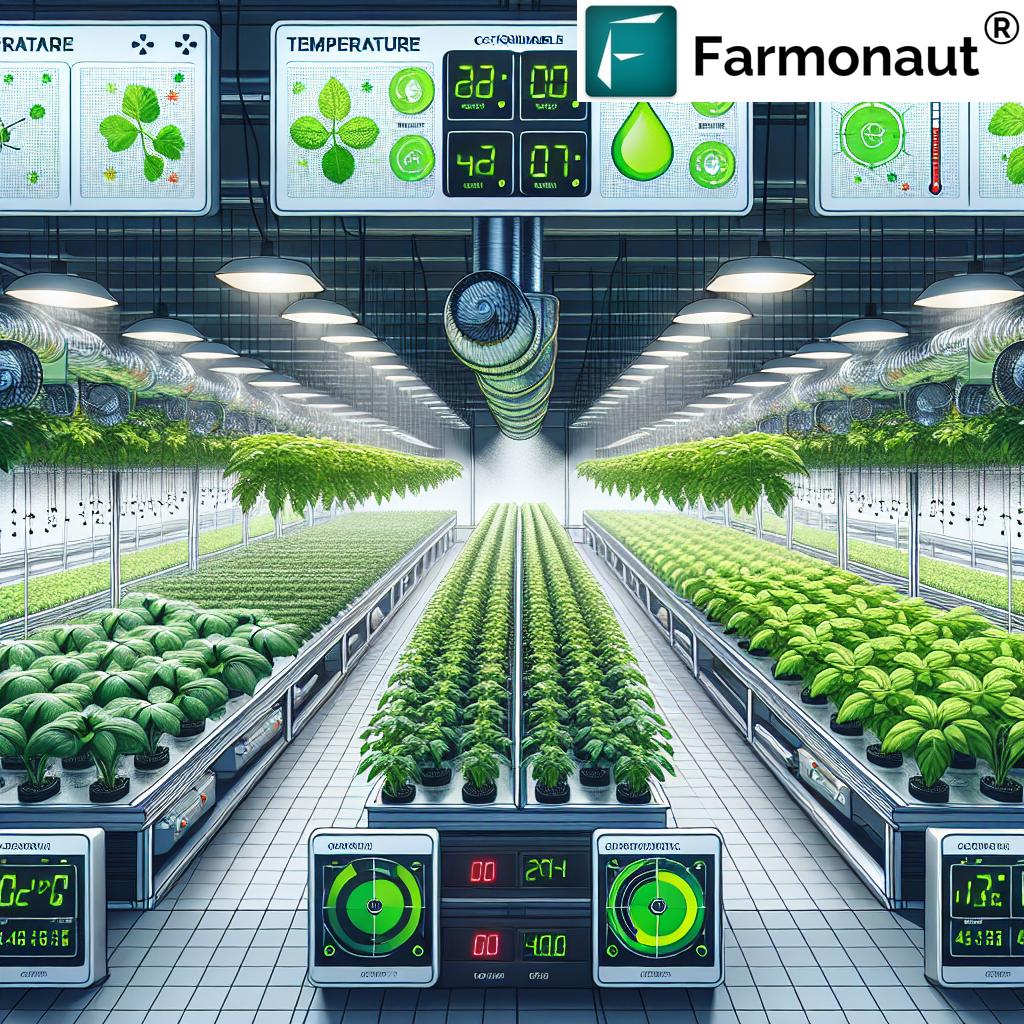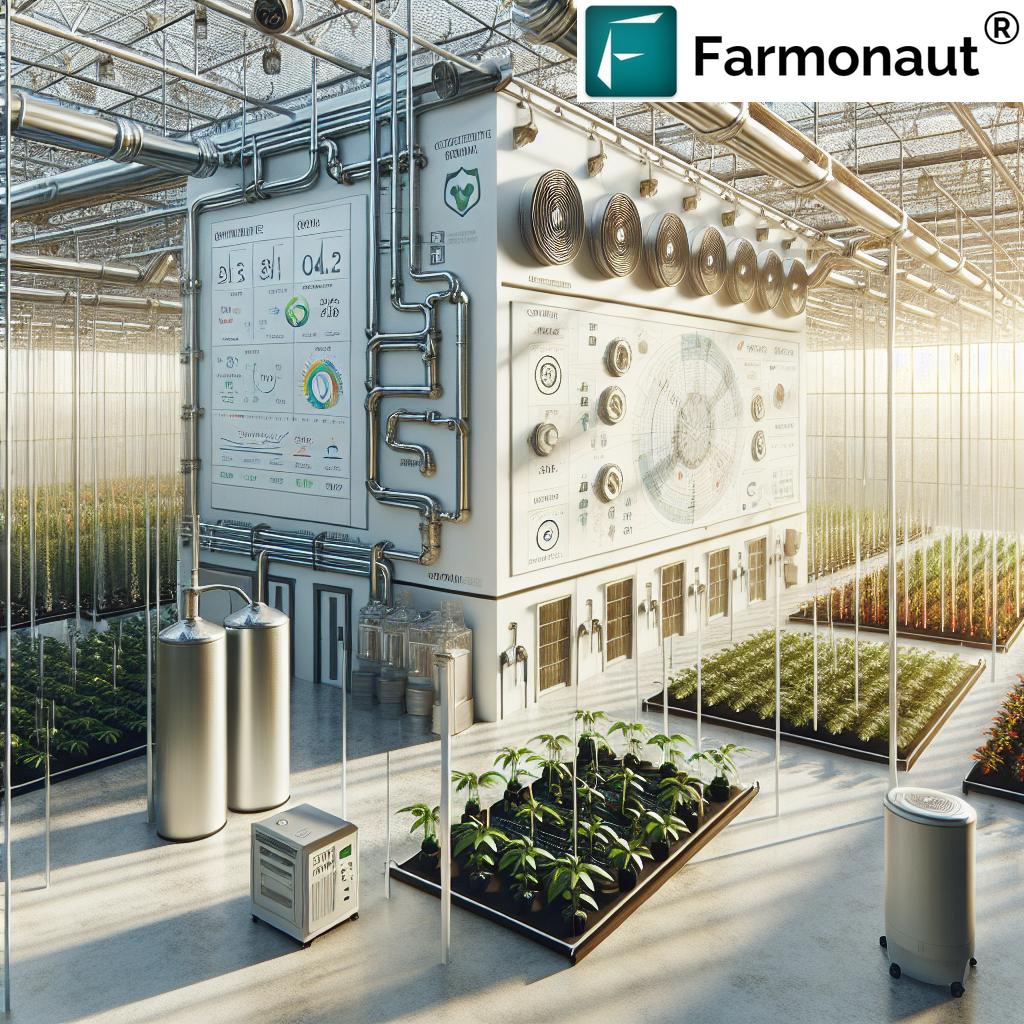Cannabis Climate Control: 7 Powerful Ways to Maximize Yields
Meta Description: Achieve top cannabis yields with advanced cannabis climate control! Discover 7 powerful climate control strategies for optimal growth, precision, and sustainability in cannabis cultivation.
“Precise climate control can boost cannabis yields by up to 30% compared to traditional growing methods.”
Introduction
Cannabis cultivation is advancing rapidly, propelled by technology and the relentless pursuit of higher yields, superior quality, and operational sustainability. At the heart of this progress lies cannabis climate control—a sophisticated approach to managing all facets of a plant’s indoor or greenhouse environment. For cannabis cultivators, optimizing temperature, humidity, lighting, and air systems is crucial to maximize yields, maintain plant health, and ensure a consistent, high-value product. This in-depth guide presents seven powerful, proven methods to revolutionize your climate control strategy, backed by technical expertise, sustainability insights, and practical tips for implementation.
Whether you’re a commercial grower, a greenhouse operator, or a passionate craft cultivator, effective cannabis climate control can be the difference between thriving, high-THC buds and disappointing, low-grade yields. Harnessing the latest advances in automation, monitoring, and energy-efficient systems, this comprehensive post will empower you to optimize every environmental factor and unlock your full crop potential.
1. Cannabis Climate Control: The Foundation for Elevated Yields
What is Cannabis Climate Control?
Cannabis climate control describes the systematic management of all environmental parameters in indoor or greenhouse cannabis cultivation. This includes temperature, humidity, lighting, air circulation, and other key cannabis cultivation environmental factors that directly influence plant growth, yields, and overall product quality. Unlike open-field agriculture, where outdoor conditions are unpredictable, controlled environments allow us to fine-tune settings for each growth stage, achieve uniformity, and mitigate risks like mold or heat stress—resulting in higher consistency and profitability.
Why is Cannabis Climate Control Essential?
- Improved Yields: Precise climate control directly increases bud density, size, and cannabinoid production.
- Consistent Quality: Uniform environmental conditions ensure that every crop cycle produces similar, desirable results.
- Plant Health: Managing humidity, temperature, and airflow reduces risks of mold, mildew, and pest infestations.
- Sustainability: Modern systems and automation minimize energy and water use, supporting sustainable cannabis greenhouse practices.
- Regulatory Compliance: Many regions require traceability and controlled growing conditions for legal sales. Blockchain-based traceability solutions can prove product origin and environmental stewardship.
2. Temperature Control: Maintaining Optimal Temperatures for Cannabis
One of the most critical cannabis cultivation environmental factors is temperature. Fluctuations outside optimal ranges can cause stunted plant growth, delayed flowering, and reduce yield quality. Here’s how to master temperature control at every stage:
Optimal Temperature for Cannabis Growth by Stage
- Vegetative Stage: 70°F–85°F (21°C–29°C) is ideal for vigorous leaf and stem development.
- Flowering Stage: 65°F–80°F (18°C–27°C), slightly cooler to encourage resin production and dense flowering.
Keeping temperatures within these parameters:
- Minimizes Plant Stress: Extreme heat or cold can cause stress, leaf curling, nutrient lockout, and reduced photosynthetic rates.
- Prevents Hermaphroditism: Temperature fluctuations, particularly heat spikes, may trigger unwanted male flowers.
- Optimizes Resin and Terpene Profiles: Cooler night temperatures during flowering (around 65°F/18°C) can enhance terpene retention and trichome density.
Strategies for Precise Temperature Control
- Heating Systems:
- Radiant Heating: Provides even warmth for plants in cooler climates, preventing root zone chill.
- Forced-Air Heating: Circulates warm air efficiently throughout the grow area.
- Cooling Methods:
- Air Conditioning: Essential in warm climates or enclosed indoor grows to dissipate excess heat.
- Ventilation: High-powered exhaust fans—combined with intake fans—expel heated air, bringing in cooler, fresh air.
- Smart Controls: Digital thermostats, temperature sensors, and automation can adjust heating or cooling, enhancing efficiency and consistent climate performance.
For greenhouse cultivators, integrating thermal curtains, insulation, and airflow management further stabilizes temperatures. Data-driven approaches using satellite imagery can offer macro-level guidance for HVAC planning and resource use.
Pro Tip:
- Monitor both ambient temperature and canopy/leaf surface temperature for complete accuracy. Infrared thermometers or thermal cameras can help detect microclimate pockets.
3. Humidity Management: Humidity Control in Cannabis Growing
“Optimal humidity levels between 50-60% reduce mold risk in cannabis crops by over 40%.”
Humidity control in cannabis growing is just as crucial as temperature management. Relative humidity (RH) directly affects a cannabis plant’s transpiration, nutrient uptake, and disease resistance. Let’s break down ideal humidity levels by growth stage and discuss the best technologies for management.
Recommended Humidity by Growth Stage
- Vegetative Stage: 40-60% RH supports healthy leaf development and reduces transpiration stress.
- Flowering Stage: 40-50% RH (Never exceed 55%!), minimizing risk of mold (e.g., Botrytis and powdery mildew).
- Late Flower/Pre-Harvest: 35-45% RH to further discourage fungal issues and foster dense bud formation.
Why is Humidity Management Essential?
- Mold and Mildew Prevention: High humidity, particularly in dense canopies, promotes pathogens like Botrytis (bud rot) and powdery mildew.
- Optimal Transpiration: Plants transpire moisture as part of nutrient cycling. Too little humidity causes leaf curl; too much leads to water-logging and slow growth.
- Greater Consistency: Controlled humidity ensures stable plant health, minimizing yield fluctuations or “popcorn bud” formation.
Techniques to Maintain Optimal Humidity
- Dehumidifiers: Essential for indoor cultivation and in humid climates.
- Fans: Proper air circulation (vertical and horizontal fans) dissipates moist air and prevents stagnant, disease-prone zones.
- Automated RH Sensors: Connect sensors to a controller, so devices adjust humidity levels automatically.
For cultivators in coastal or high-humidity climates, investing in commercial-grade digital humidistats and scalable dehumidifiers is not just a precaution, but a necessity for consistent product quality.
Related: Access precise weather and satellite data using the Farmonaut API to support real-time environmental decisions and optimize humidity control throughout the crop cycle. Learn more about integration here.
For disease management, it’s critical to implement how to prevent mold in cannabis grow rooms strategies, such as never letting moisture condensate on surfaces, spacing plants to improve air flow, and regularly sanitizing equipment.
4. Lighting and Photoperiod: Best Lighting for Cannabis Plants
Light is the fuel that powers cannabis photosynthesis, dictating growth rates, leaf size, and bud structure. Modern cannabis climate control leverages advancements in lighting systems to deliver precise light intensity, spectrum, and “day-night” cycles tailored to every growth phase.
Lighting Needs by Cannabis Growth Stage
- Vegetative Stage:
- Light Cycle: 18-24 hours of light per day supports rapid expansion and branching.
- Spectrum: Blue-rich (6500K) LED lights or metal halide (MH) bulbs promote sturdy growth.
- Intensity: 400–600 μmol/m²/s PPFD (Photosynthetic Photon Flux Density).
- Flowering Stage:
- Light Cycle: Switch to 12 hours of light and 12 hours of uninterrupted darkness, triggering flowering.
- Spectrum: Red-rich (2700K) LEDs, high-pressure sodium (HPS), or full spectrum LEDs for dense bud production.
- Intensity: 600–1000 μmol/m²/s PPFD for robust flower development and THC synthesis.
Photoperiod management is critical—inconsistent dark periods (light leaks) can cause delayed flowering or hermaphroditism. Automated timers and light-proofing are essential for indoor operations.
Best Lighting for Cannabis Plants: HID, LED & More
- High-Intensity Discharge (HID):
- MH Bulbs: Ideal for vegetative growth.
- HPS Bulbs: Gold standard for flowering, but produce more heat (requiring additional cooling).
- LED Grow Lights:
- Advantages: High energy efficiency, customizable spectrum, low heat output—major sustainability benefits.
- Emerging Tech: Some advanced LEDs feature “sunrise/sunset” simulation and dimming capabilities for precise cycle control.
- Automated Lighting Systems: Digital controllers adjust intensity and duration in real time, optimizing growth and energy consumption.
Pro Tip: Light Uniformity
Ensure even coverage across the canopy—use light movers, reflective surfaces, or overlapping fixtures to prevent shaded “dead zones” that limit yields.
5. Air Circulation and Ventilation: Air Circulation for Cannabis Growth
Strong, disease-free cannabis plants depend on proper air movement. Without adequate air circulation and ventilation, humidity builds up, CO₂ becomes depleted, and pests or mold can quickly take hold.
Essential Air Circulation Hardware
- Oscillating Fans: Horizontal fans push air across the canopy, while vertical circulation prevents stratification and promotes uniform temperature and humidity distribution.
- Exhaust Fans: Expel hot, humid air from the grow space, reducing heat and odors.
- Intake Fans: Pull in fresh, CO₂-rich air for optimal photosynthesis.
- Evaporative Cooling Pads: In greenhouses, these systems utilize water evaporation for cooling in warm, arid climates.
Benefits of Air Circulation for Cannabis Growth
- Ensures uniform climate throughout the grow space.
- Strengthens plant stems, making them more resistant to heavy buds and accidental breakage.
- Reduces risk of mold and mildew by keeping foliage dry.
- Facilitates even distribution of CO₂, nutrients, and optimal light penetration.
Best Practices for Airflow
- Ensure multiple fans are strategically placed: canopy level, mid-zone, and at return air points.
- Calculate air changes per hour (ACH); aim for 20-30 ACH in high-density rooms.
- Use speed controllers for fans to adjust output depending on temperature and humidity readings.
- Regularly clean fans and ducting to prevent dust buildup, which harbors pests and pathogens.
6. Environmental Monitoring and Automation: Automated Greenhouse Climate Systems
Manual management simply cannot match the accuracy and responsiveness of today’s automated greenhouse climate systems. Integrating intelligent controllers, real-time sensors, and AI-driven decision support elevates climate control to a new level of efficiency and reliability.
Key Components of Modern Automated Greenhouse Climate Systems
- Environmental Sensors: Track temperature, humidity, CO₂, light intensity, and soil moisture with precision.
- Central Controllers: Aggregate sensor data and activate connected devices (heaters, fans, humidifiers, dehumidifiers, vents, lights) as needed.
- IoT Integration: Cloud-based management enables remote monitoring and adjustments via mobile devices or computer.
- AI and Machine Learning: Advanced systems can learn from historical crop cycles, predicting climate needs and optimizing energy usage for each crop stage.
- Blockchain Traceability: For compliance and transparency, integrating with platforms like Farmonaut product traceability ensures every environmental intervention is logged and verifiable.
Benefits of Automation & Monitoring
- Consistency: Automated equipment responds to real-time changes, keeping the climate stable and reducing yield fluctuations.
- Efficiency: Only running equipment as required minimizes energy expenditure and reduces operational costs.
- Data-Driven Decisions: Historical data uncovers trends and optimizes protocols for future crop cycles.
- Compliance: Automated logs and reports simplify environmental compliance and batch record-keeping.
7. Greenhouse Design and Sustainability: Sustainable Cannabis Greenhouse Practices
The construction and layout of your cannabis grow space powerfully impacts your ability to maintain consistent temperature, protect against heat loss, and minimize energy consumption. Let’s explore the best sustainable cannabis greenhouse practices that support top yields and environmental stewardship.
Greenhouse Materials and Insulation
- Double-Walled Polycarbonate: Delivers superior insulation compared to single-layer plastics. Reduces internal temperature fluctuations and energy requirements for heating or cooling.
- Glass Enclosures: Maximize natural sunlight, though they may need shading in hot climates to avoid excess heat gain.
- Thermal Curtains: Internal shading systems help regulate temperature and RH, especially during hot summer or cold winter nights.
- Air Sealing: Sustainable greenhouses are tightly sealed to prevent unwanted air infiltration, maintaining stable climates and reducing HVAC strain.
Energy Efficient Cannabis Cultivation Practices
- LED Lighting: Modern LEDs use up to 50% less energy than HID or fluorescent fixtures, enhancing sustainability and reducing electrical costs.
- Variable-Speed Fans and Pumps: Adjust power according to real-time demand, cutting unnecessary energy use.
- Renewable Energy Sources: Solar, wind, and even geothermal technologies are becoming more popular for energy efficient cannabis cultivation operations.
- Heat Recovery and Water Reuse: Systems that recycle exhaust heat or capture condensate water can greatly reduce resource input.
Integrating these design elements contributes not only to sustainability but also to regulatory compliance, as many jurisdictions increasingly demand eco-friendly cultivation practices. For those seeking to track impact, Farmonaut’s carbon footprinting solutions offer actionable insights for minimizing environmental impact and maximizing operational responsibility.
Climate Control Method Comparison Table
How Farmonaut Supports Sustainable and Precise Cannabis Cultivation
At Farmonaut, we are dedicated to driving innovation and precision agriculture—including in advanced cannabis cultivation. By leveraging satellite imagery, artificial intelligence, and blockchain technology, we provide growers and agribusinesses with actionable insights to optimize climate control, resource management, and carbon tracking in real-time.
- Satellite-Based Crop Health Monitoring: We use multispectral satellite data to visualize vegetation health (NDVI), soil moisture, and environmental stress. With this, cultivators can identify microclimate zones that may be prone to excess humidity, temperature fluctuations, or insufficient air circulation.
- AI Advisory System (Jeevn AI): Our personalized advisory system delivers real-time recommendations for climate management, irrigation scheduling, and sustainable practices—maximizing yields while reducing waste and operational costs.
- Blockchain Traceability: With our traceability platform, growers can document every batch’s environmental journey from seed to harvest, ensuring regulatory compliance and consumer trust.
- Fleet and Resource Management: For large-scale greenhouses and multi-facility operations, we offer fleet and equipment management tools to optimize logistics, scheduling, and maintenance—reducing downtime and supporting energy efficient cannabis cultivation.
- Carbon Footprinting: Our carbon tracking capabilities provide data-driven insights that help cultivators measure and reduce their environmental impact, in alignment with the principles of sustainable cannabis greenhouse practices.
- Mobile and Web Accessibility: The entire Farmonaut ecosystem—accessible via App—is designed to put remote farm and facility management at your fingertips.
We invite cultivators, agribusinesses, and researchers to explore Farmonaut’s large-scale management solutions or integrate our satellite and weather data using the Farmonaut API. For those in need of plantation or forestry advisory, use our comprehensive advisory tool for robust crop planning.
Frequently Asked Questions (FAQ)
Q1: What are the optimal temperature ranges for each stage of cannabis growth?
Vegetative Stage: 70-85°F (21-29°C).
Flowering Stage: 65-80°F (18-27°C), slightly cooler to enhance resin and terpene development.
Q2: How can I control humidity to prevent mold and mildew in my cannabis grow room?
Invest in digital humidistats, programmable dehumidifiers, and powerful air circulation. Keep RH between 40-60% during veg and 40-50% during flowering; in late flower, drop to 35-45%. Use spacing and leaf pruning to improve airflow and inspect for condensation or pooling water frequently.
Q3: What’s the best lighting system for cannabis cultivation—HID or LED?
For energy efficiency, spectrum control, and sustainability, LED systems are now the industry standard. However, high-intensity discharge (HID) options like HPS remain popular for seasoned cultivators due to familiarity and raw wattage, but require stronger cooling and ventilation to manage excess heat.
Q4: Do I need automated environmental controls for a small grow?
Automation isn’t mandatory for small grows, but digital sensors and timers greatly improve consistency and quality. Even in small tents, automated relays can run exhaust fans, humidifiers, and lights on schedule to minimize risks and stress.
Q5: How does Farmonaut support cannabis growers with climate control?
We provide satellite-based environmental monitoring, AI-driven advisory, and resource management tools that enhance data-driven climate decisions and resource use—supporting yield maximization and sustainable cannabis greenhouse practices.
Conclusion
Mastering cannabis climate control is the single most powerful way to optimize yields, improve product quality, and ensure operational sustainability in commercial and craft cannabis cultivation. By integrating precise temperature and humidity management, advanced lighting and air circulation systems, real-time environmental monitoring, and energy-efficient practices, cultivators create an environment where healthy, robust plants thrive—harvest after harvest.
At Farmonaut, we believe in the power of precision agriculture, responsible environmental management, and data-driven decisions to propel cannabis growers into a future defined by innovation, sustainability, and scalable success. Leverage our platform and solutions to elevate your operation to the next level of climate control and profitability.
- Explore advanced carbon footprinting, fleet management, and product traceability tools
- Experience seamless farm management via our web platform and mobile apps, all backed by state-of-the-art technology
- Access Farmonaut’s API for next-level custom environmental data and climate monitoring
Ready to maximize your cannabis yields with innovative climate control? Start with Farmonaut today!











